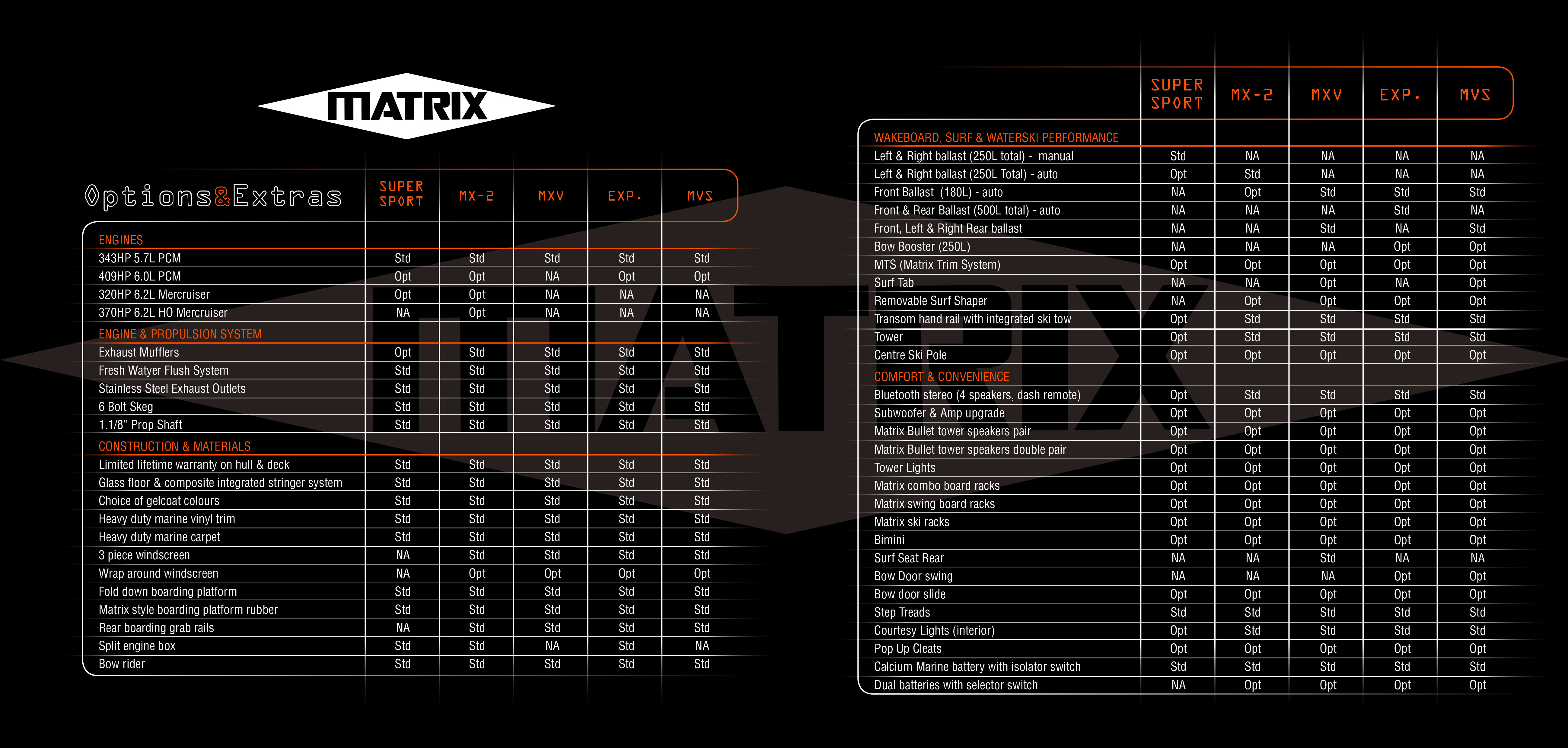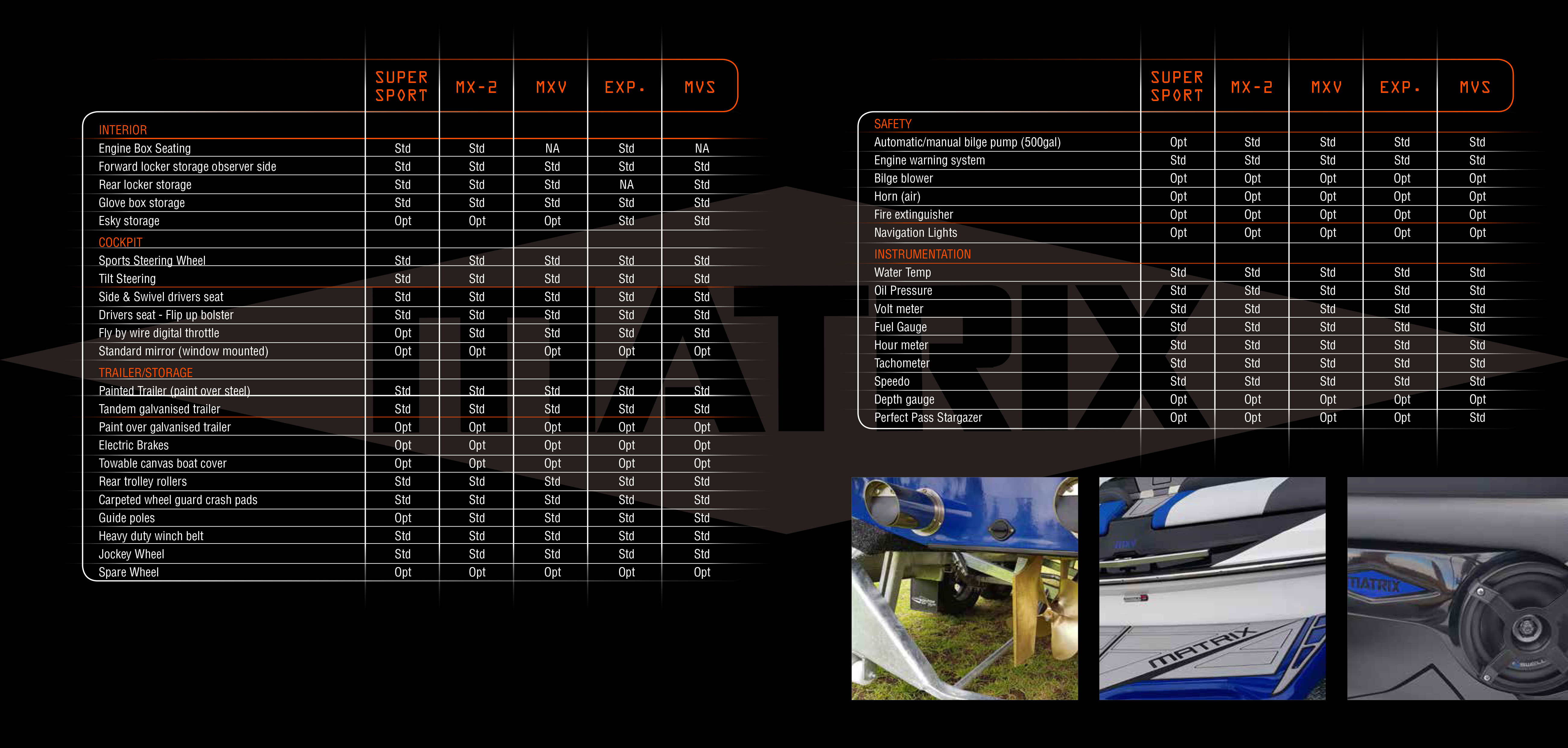Matrix manufactures each boat using international standard boat building technology in our South Australian plant. We welcome you to compare our construction methods against our competitors.
Watch Video

1 Step
Clean and perfect moulds are the key to a perfect high gloss gelcoat finish. All moulds are inspected for damage, cleaned out them waxed to perfection if needed.
2 Step
Using the latest technology in gelcoat applicator guns, gelcoat is sprayed to an exacting thickness and checked to the millimetre. Our gelcoat is a product of Nupol Composites - the highest quality gelcoat producer in the world.
3 Step
A layer of barrier gelcoat is applied between the gelcoat and the first layer of fibreglass, as a back up, to prevent gelcoat print-though. Matrix is one of the very few boat-builders who currently use this preventive measure to ensure the long-term beauty of your boat.
4 Step
The SKIN and SHELL stage: Using state of the art fibreglass deposit guns we spray over the cured gelcoat with high quality low shrink polyester resin, then spraying fibreglass, saturating it with more resin and hand-rolling every crevice to remove air pockets.
Matrix fibreglass laminating system, is a combination of hand-laid and gun-laid composites. Premier-quality mat, woven fibreglass, honeycomb board and core mat is cut into the appropriate shapes and thickness for each individual boat model. We lay up to 20 layers of fibreglass and composites on each boat to ensure maximum strength and longevity.
Fibreglass bearers and floors and hand-laid which give superior strength-to-weight ration. They are tagged into the hull and fibreglass bonded to the with cross woven laminates, thus giving Matrix a superior structural bond throughout the motor cradle and chassis system. A solid aluminium flatbar is also glassed into the bearer, completing the inbuilt motor cradle, which is used to through bolt fasten the mercruiser motor.
Our Matrix bearer/chassis system is the most advanced construction method used today. It is lighter, stronger and more durable and will not rot or de-laminate in years to come.
Aluminium and high-density polyethylene (HDPE) pieces are glassed into the structure for strengthening external hardware which allows the tension to be moved to these plates, ultimately preventing cracking in the fibreglass.
PVC conduit is then laminated into the deck for easy cable and wire routing.
5 Step
The deck is sanded then carefully lifted out of the mould with leaves and jigs, turned over and placed onto trolleys for close inspection. All holes are cut and drilled to precise templates, then sanded free of sharp edges ready for assembly.
While the hull is still in the mould, a 5-tonne press is lowered into the hull and ratcheted down to hold the floor firmly in place. While the press holds together the flooring system, our boat builders apply expanding close-cell floatation foam in the open cavity between the hull and floor. This ensures less hull movement, better floatation, noise and vibration dampening and increases hull rigidity. The hull is sanded, lifted out of the mould and placed on the trolley.
6 Step
Our quality control manages and supervisors methodically check, inspect and report on every boat that comes down the line.
7 Step
A shoe box join method is used to bond the hull and deck together and additional fibreglass layers are glassed to the inside join, completing the bond and giving superior strength. In a Matrix, seat bases are part of the deck mould. These frames are fibreglass bonded to create the most solid boat in the industry. All seat frames are made of moulded fibreglass, which will not soften in hot weather and over time will not break loose from brackets, as plastic frames will. Fibreglass seat frames will also retain their shape and last forever. The entire bonding system on Matrix boats eliminate the use of screws, bolts and brackets, which increases strength in the hull and decreases fatigue in fasteners as a result of movement between components.
8 Step
Heavy duty marine carpet is laid into the boat, windscreens fitted and underwater gear lined up and bolted through. Many internal and external fittings are fastened here to the pre marked or template holes.
9 Step
When a boat enters the assembly building at the station, installers are careful to align the engine properly, securing it in to the motor mounts and connecting the drivetrain.
All holes for each powerplant are drilled with the motor in line, to ensure every engine is located precisely where it was engineered to be. After drilling, each hole is tapped in preparation to bolt the engine in. After the motor is installed the rest of the standard and optional extras are fitted with precise templates to ensure a perfect fit.
Our windshields are built with thick, durable extrusion and solid support brackets. All Matrix towers, tower-speaker housings, tower-light assemblies, and rotating boat racks (patent pending) are made locally and installed during fit-out.
10 Step
Matrix produce our own custom upholstery using high and low-density foams, glass frames and backs (instead of wood), premium foam-backed vinyl, and heavy-duty stitching. Many grades of foam are used to achieve maximum comfort and stitching durability. Every metal component on a Matrix is either stainless steel or other non-corrosive material. Even upholstery staples are stainless steel.
11 Step
All Matrix boats are motor tested for the final stage before their last clean. Testers meticulously scrutinize engines, all fittings, all electrical hardware and gauges, so you are spared any surprises.
12 Step
With all systems "go", we do a final cleaning, and then shrink wrap the boat to keep them clean and free from travel damage, before shipping them to dealers or handing them over to sales staff for delivery to the customer.